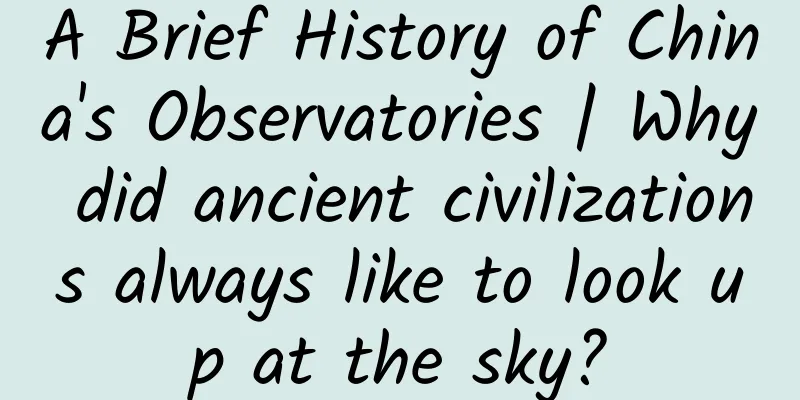A Brief History of China's Observatories | Why did ancient civilizations always like to look up at the sky?

|
Archaeology is often a job of digging deep into the ground, but sometimes, we can also dig out a piece of sky from underground. This sky is hidden in the ruins of one observatory after another, and is reflected in the spiritual world of each of us. Standing on the ground and looking up at the stars, this is the ultimate romance. The starry sky is vast, yet deep. For humans in primitive society, it is a mysterious place controlled by the vastness. The wandering of the sun, moon, and stars is beyond the reach of human touch. Therefore, the ancients built tall observatories, through which officials measured celestial phenomena at night and recorded the movements of celestial bodies. Emperors used celestial phenomena to implement political decisions. How did stargazing become so closely connected to everyone, and then remain hidden in a corner of the palace? What do those mysterious observatories represent? Today, let’s talk about the observatory and the astronomical world behind it. 01 Starting from "Witches" The Chinese have a very long history of exploring the universe. As early as the Yellow Emperor period, people had begun to learn to observe celestial bodies with their naked eyes, trying to explore their movement patterns. For people still living in primitive society, the rising and setting of the sun and the moon, and the movement of the stars, are incredible phenomena in themselves. Even the remoteness and unknownness of the universe cast a huge shadow on human beings. The movement of these huge celestial bodies affects climate change and brings about the change of seasons. However, in the face of them, humans seem small and unreachable. A star map of the 28 Mansions and the 12 Zodiac constellations in the Zhang family tomb in Xuanhua, Hebei Province (1116). The ancients observed the shapes of the stars with their naked eyes and recorded their orbits. The most complete map of the twenty-eight constellations found in the Han tomb in Jingbian, Shaanxi Perhaps out of fear or reverence, people began to consciously connect strange celestial phenomena with human misfortunes and blessings. So, from this moment on, a person's fate began to be connected with heaven and earth: if one wanted to find answers in the vicissitudes of life, one must first obtain revelation from heaven. The prototype of early Chinese astronomy was established under such a background. At that time, astronomy did not have the characteristics of a modern discipline. It was closer to the form of astrology - its knowledge system was centered on mathematics and calendar, and its ultimate goal was to provide predictive services for life on earth. Song Dynasty painting "Fairy Riding a Luan", source: Palace Museum. In the Chinese mythology system, there are many stories related to the universe, such as Kuafu chasing the sun, Chang'e flying to the moon, and the heavenly dog eating the moon... These mysterious and moving stories add a touch of inevitability to the connection between man and heaven and earth. This cosmological view that connects man with the universe dominated Chinese society for nearly a thousand years. It is also because of this that Chinese astronomy has been unable to escape from political struggles since its birth. At the beginning, the primary need was to find someone who could communicate directly with heaven and earth. This role was initially played by "Wu Sha". In the early society before the rise of the centralized system and the feudal era, Wu Sha was an important role in each tribe. The oracle bone inscriptions of the Shang Dynasty. These characters carved on tortoise shells and animal bones are the divination inscriptions left by the witches and shamans. They can talk to heaven and communicate with gods. With this unique ability, witches and shamans manipulate the time of heaven and earth while coveting power in the human world. The witches' supernatural powers brought about a profound witch culture: a person's birth, aging, illness and death must all be predicted by witches, who then make decisions that are beneficial to them based on the results of the divination. A scene of a shaman performing divination, printed on a Han Dynasty stone relief Rooted in the simple belief that "people should leave their fate to heaven and earth", witches and shamans had monopolized the task of observing celestial phenomena and conveying predictions for a long time. However, when time entered the Yin and Shang Dynasty, for the same reason, the witch and shaman culture gradually declined. 02 When stargazing becomes a private school In an era when imperial power was gradually rising, the power also gradually expanded the ambitions of emperors. For these rulers, simply possessing the power to govern the country is not enough. In their view, the ability to obtain this "heavenly secret" can only belong to themselves. Since the Western Zhou Dynasty, monarchs of every dynasty have been constantly trying to incorporate this power into their own hands: first, shamans were incorporated into the formal bureaucratic system, and then, with the disappearance of shamans, stargazing became a "royal private school" , and observing celestial phenomena became an activity exclusive to the royal family. In the Zhou Dynasty, shamans still had considerable power, but the work of calendar and astronomy was handed over to the historians who were appointed separately. At this time, the historians often carried out their work in the form of collecting folk songs. The descriptions of the changes in solar terms in the Book of Songs, such as "the fire flies in the seventh month, and the clothes are given in the ninth month", were the results of their work in recording weather and calculating solar terms. During the Spring and Autumn Period, these astronomical observers left the world's first accurate record of Halley's Comet. The Spring and Autumn Annals recorded that in 613 BC, "a star entered the Big Dipper", which refers to Halley's Comet. This record was more than 600 years earlier than that of Europe. During the Warring States Period, two grassroots stargazers, Gan De from Qi and Shi Shen from Wei, separated astronomy from astrology. Gan De wrote "Astronomy and Astrology" and Shi Shen wrote "Astronomy", which sorted out and summarized the basic knowledge of planetary motion and star positions. Later generations combined these two works and called them "Gan Shi Xing Jing". At this time, stargazing was still an activity that everyone could do . By the Qin and Han dynasties, shamans were only responsible for dancing to worship gods and participating in national sacrifices as subordinate officials. The work of calculating astronomy and calendar was taken over by the Grand Historian . During the Qin and Han dynasties, the Grand Historian was also responsible for compiling historical books. Sima Qian, who wrote the book "Records of the Grand Historian", was the Grand Historian. After the Western Han Dynasty, witches officially disappeared from the bureaucratic system and gradually evolved into a profession active among the people. A witch performance in a village The abolition of witch officials did not mean the disappearance of witch culture. In fact, when witches and shamans went to the people, they still had a broad belief base. However, after the Han Dynasty, the main functions of witches changed fundamentally. They were completely separated from the field of astronomy and calendar, and turned into wizards who entertained gods and ghosts and prayed for people. During the Western Jin Dynasty, the imperial court issued a decree to "ban the study of astrology, prophecies and divinations". Astronomy activities were prohibited among the people, and stargazing officially became a "private school" of the imperial court. At this point in the development of Chinese astronomy, it was already deeply involved in the power struggle : on the one hand, the witch officials were officially expelled, indicating that the power of the monarch had reached a peak. From then on, the monarch himself became the only person representing the will of heaven. The royal power was granted by God, and the emperor became the human ruler authorized by heaven. On the other hand, observing celestial phenomena is not just a simple scientific observation, it also represents a new system - the imperial order under the interaction between heaven and man . The star map drawn by Chen Zhuo, the Grand Historian of Wu during the Three Kingdoms period, was a product of this demand. Chen Zhuo combined the observations of Gan De and Shi Shen to compile a star catalog of 283 stars and 1,464 stars, and based on this, he drew the star system of the Three Enclosures and the Twenty-Eight Mansions. This is a system that connects astronomy with high-ranking dignitaries, and its fundamental purpose is to provide rationality for the imperial order. The "Book of Sui: Records of Emperors" once recorded that during the reign of Emperor Yang of Sui, "on the Jiazi day, Mars entered Taiwei." The "Mars entered Taiwei" here refers to a celestial phenomenon. The Sui Dynasty fell during the reign of Emperor Yang of Sui, so the historians made this record. This also reflects that the ancients generally believed that strange celestial phenomena could predict the rise and fall of a dynasty. The rationale behind this is rooted in this strong connection between "heaven and emperor." At this point, the purpose of stargazing had undergone a fundamental change - it became the basis for ensuring the legitimacy of imperial rule . It was for this reason that the rule of "forbidding star gas" continued from the Western Jin Dynasty to the Ming and Qing Dynasties. For this reason, every dynasty has issued prohibitions related to stargazing. For example, during the Tang Dynasty, the law stipulated that private households were not allowed to keep instruments for observing astronomy or astronomical books, and "violations would be punished by two years in prison." If someone observed astronomical phenomena and spread rumors to mislead the public, they would be sentenced to death by hanging. After stargazing was completely monopolized by the royal family, each dynasty established different institutions to carry out observation work: the Sui Dynasty had the Taishijian, the Tang Dynasty had the Taishiju and Sitiantai, the Song Dynasty had Sitianjian and the Tianwenyuan, and the Ming and Qing Dynasties had the Qintianjian. During the Qing Dynasty, most of the directors of the Imperial Observatory were foreigners. The picture shows Tang Ruowang, a famous director of the Imperial Observatory in the Qing Dynasty, who was from Cologne, Germany. From the Imperial Astronomical Observatory to the Imperial Astronomical Observatory, the names and organizations have changed over time, but their essential work has remained the same: using the name of astronomy to actually seek legitimacy for human affairs. 03 Brief History of the Observatory The emergence of the observatory is the product of this "private education" trend. From the beginning, the tall observatory was built to prevent civilian stargazing activities. Therefore, the observatory was set up deep in the palace or combined with the royal family's place of worship. The observatory was therefore shrouded in a mysterious veil, its appearance was shadowy and could not be seen by ordinary people. Beijing Ancient Observatory. The observatory not only provided a place for officials to observe celestial phenomena, but also, due to its open location, the emperor would go up to the platform to enjoy the view when the weather was fine. When did the observatory appear? We have not yet found a clear record. The first observatory with clear records in history was built in the Later Zhao Dynasty in the early Eastern Jin Dynasty. The Later Zhao was a regime established by Shi Le of the Jie tribe in 319 AD in southern Hebei Province. Shi Le's nephew Shi Jilong built a large number of buildings in Xiangguo and Ye during the Xiankang period of the Jin Dynasty (335-342), including an observatory. According to the records, the observatory was built in a very luxurious and sophisticated style, and was equipped with simple astronomical instruments. The sundial is an astronomical instrument that specifies the time or minute according to the position of the sun's shadow. It was also a commonly used timekeeping instrument in ancient my country. In the Sui Dynasty, the observatory was called Lingtai. Emperor Yang of Sui once "sent 40 palace ladies to the Bureau of Astronomy and issued a special order to Yuan Chong, who taught them how to observe the stars and astrology. Those who completed the task were allowed to enter the palace to participate in divination and verify the clouds." It is very clear here that Emperor Yang of Sui, Yang Guang, selected 40 palace ladies and handed them over to Yuan Chong, who taught them how to observe the celestial phenomena in Lingtai. The Tang Dynasty also built a "Lingtai". It is recorded in historical materials that on March 19th of the first year of Qianyuan (758), "the Taishijian was changed to Sitiantai, and the official office was moved to the southeast corner of Yongningfang, with Lingtai inside." During the Song and Jin Dynasties, "Lingtai" was renamed "Sitiantai". On the platform, "there are instruments that were first made in the Jin Dynasty and completed in the Yuan Dynasty". The instrument here refers to the armillary sphere made by Shao Yan in the early Southern Song Dynasty. The emperor at that time placed the armillary sphere in his palace to "measure celestial phenomena". During the Yuan Dynasty, "Sitiantai" was changed to "Taitai". It was not until the Ming and Qing Dynasties that the name was fixed. After the Ming Dynasty, places for observing celestial phenomena have been called observatories. The armillary sphere is an astronomical instrument used in ancient China to determine the positions of celestial bodies. The armillary sphere made by Shao E in the Southern Song Dynasty has been lost. The only surviving armillary sphere is a replica made during the Zhengtong period of the Ming Dynasty, which is now preserved at the Purple Mountain Observatory. Basically, every dynasty in China has built an observatory, but there are not many records about the architectural form of the observatory. At present, a large number of construction materials and historical objects related to the observatory come from the Ming and Qing dynasties. For example, the "Records of Emperor Shenzong of the Ming Dynasty" records that the setting of the observatory had already been fixed in the Ming Dynasty. Sun Chengze also described the general situation of the observatory in "Records of Chunming Mengyu": "The observatory is located in the southeast corner of the city. On the platform there is a celestial sphere, which is similar to the Xuanji in the world. They are all made of copper and are suspended on four pillars with copper dragon frames. There is also a simple instrument, which is similar in shape... The jade balance is also made of copper, which is like a ruler but with curved ends and two holes. You can look through the holes to observe the central star. There is also a copper ball that rotates left and right to represent the celestial body, which is contained in a square box. The box is surrounded by the true shapes of the twenty-eight constellations, and there is an inscription of the orthodox emperor on the south side. There is a ruler for measuring the sky in a small room under the platform, and a copper man is built, holding the ruler and facing north. The top of the room is hollowed out to observe the length of the shadow at noon... In the middle is the Ziwei Hall, and beside the hall there are copper pots and clepsydras." The restoration diagram of "Qintianjian Sitiantai" by later generations Today, for us, visiting the observatory has lost its former significance: the change of its name and the determination of its location reflect the traces of different powers competing here. To us now, it is more of a "mysterious" and "ancient" building, but it is another reflection of the political struggle for thousands of years . Today, the "king" is gone, and the starting point of the supreme power has disappeared in the whirlpool of history as the times progress. Only this ancient building, which has gone through wind and frost, stands tall. 04 Where to see the observatory? At present, there are not many observatories that we can see. They are often easily reduced to dust with the fall of a dynasty. Among the observatories that have survived to this day, we recommend four of them to you. They come from different eras and have different characteristics. They often become the last information conveyed to us by that era due to their special status . 1) Beijing Ancient Observatory Address: No. 2, Jianguomen East Biaobei Hutong, Dongcheng District, Beijing Tickets: 20 yuan for adults, 5 yuan for primary and secondary school students Opening hours: 9:00-17:00, closed on Mondays The Beijing Ancient Observatory was first built during the Zhengtong period of the Ming Dynasty (1442) and is one of the oldest observatories in the world. It is famous for its complete architecture, exquisite instruments, long history and unique position in the cultural exchange between the East and the West . From the beginning of the Zhengtong period of the Ming Dynasty to 1929, the Beijing Ancient Observatory had a history of nearly 500 years of astronomical observation. It is particularly worth mentioning that during the reigns of Emperor Kangxi and Emperor Qianlong of the Qing Dynasty, due to the influence of Western learning, the Beijing Ancient Observatory successively added eight large copper astronomical instruments, all of which adopted European astronomical measurement systems and instrument structures. They are not only practical astronomical observation tools, but also historical relics that witness the exchanges between China and the West. After the founding of New China, the Ancient Elephant Observatory was transferred to the Beijing Planetarium and is now a national key cultural relic protection unit . 2) Taosi Observatory Address: Taosi City Ruins, Xiangfen County, Shanxi Province Tickets: No Opening hours: Open all day Located in the ruins of Taosi City in Xiangfen County, Shanxi Province, Taosi Ancient Observatory has a history of about 4,700 years. It was formed at the end of primitive society in 2100 BC, nearly 500 years earlier than the world-recognized Stonehenge Observatory in the UK (1680 BC) . It is composed of 13 rammed earth pillars in a semicircular shape with a radius of 10.5 meters and an arc length of 19.5 meters. From the observation point, the sunrise direction of the Taer Mountain can be observed through the slits in the earth pillars to determine the seasons and solar terms and arrange farming. The Taosi Ancient Observatory is an important physical example for the study of astronomy and calendar in ancient China. It confirms the true historical background and social reality of the statement in the Book of History: The Canon of Yao that "calendars are used to observe the sun, moon, and stars, and teach people the time". Currently, this archaeological achievement has been designated as a major national archaeological discovery by the Chinese National Cultural Relics Department. The solar calendar of 20 solar terms obtained by simulation observation of Taosi Observatory, source: "How to Explore What the Ancients Thought" 3) Qingdao Observatory Address: No. 21, Guanxiang 2nd Road, Shinan District, Qingdao City, Shandong Province Ticket price: 8 yuan/person Opening hours: Open irregularly The Qingdao Observatory was founded by the Germans in 1898, and was occupied twice by the Japanese army. It was returned to China after the victory of the Anti-Japanese War in 1946. After the liberation, it was taken over by the Navy. The main building has 7 floors and is 21.6 meters high. It is one of the three largest observatories in the Far East in modern times . Qingdao Observatory photographed by Japanese In 1957, the astronomy, geomagnetism and seismology departments of Qingdao Observatory were transferred to the Chinese Academy of Sciences. From then on, Qingdao Observatory was divided into two parts: the meteorology department was assigned to the Navy; the other part was named "Qingdao Observatory of Purple Mountain Observatory, Chinese Academy of Sciences". Qingdao Observatory plays an important role in the history of meteorological and marine science development in modern China. In addition, the scenery here is unique and surrounded by green plants. Among the many hilltop parks in Qingdao, only "Dome Elephant Viewing" has been listed as one of the ten scenic spots in Qingdao. 4) Dengfeng Observatory, Henan Address: China Astronomical Museum, Shicong Street Observatory, Gaocheng Town, Dengfeng City, Zhengzhou City, Henan Province Tickets: Free Opening hours: 8:30-18:00 Dengfeng Observatory was built by astronomer Guo Shoujing between the 13th and 17th years of the Zhiyuan period (1276-1280) and is the oldest existing observatory in China . The entire observatory is a building that is enlarged according to the "guibiao", consisting of a platform surrounded by spiral steps and a stone gui that is laid flat from the groove on the north wall to the north. The platform is square and bucket-shaped, and the four walls are made of water-ground bricks. The stone gui on the north side of the observatory is used to measure the length of the sun's shadow, so it is also called the "sky ruler". In 1961, Dengfeng Observatory was announced as the first batch of national key cultural relics protection units by the State Council of the People's Republic of China. References: "The Imperial Observatory of the Ming Dynasty" by Wang Yunjie "Chinese Astronomical Archaeology" by Feng Shi What kind of institution is the Imperial Observatory? Zeng Xun "The Inner Observatory and the Imperial Astronomical Observatory in Chinese History" by Guo Shirong and Li Di -END- Editor: Fried Egg The picture comes from the Internet. If there is any infringement, please contact us to delete it. Source: Art Travel Culture |
<<: Beijing residents are troubled by fleas. How can fleas still exist in the 21st century?
>>: The French plane tree is not a sycamore and is not native to France.
Recommend
Scoping in Android and Hilt
Scoping object A to object B means that object B ...
Exposed! The "tissues" you use every day are so dirty! If you use them incorrectly, you'll be in big trouble!
Tissues are daily necessities that we come into c...
How to achieve growth at low prices? Let you know Xiaomi's business model
From launching MiTalk and MIUI systems to making ...
Why would anyone like to eat Houttuynia cordata?
When talking about Houttuynia cordata, the first ...
Papi Jiang's success also relies on the recommendation of seed users. Perhaps social networking is the bargaining chip for mobile video to ask for capital.
As 2016 draws to a close, mobile videos represent...
A brief analysis of QQ, WeChat and Momo: Why they can capture the hearts of users
A friend once lamented: Looking at the social pro...
"18 Psychological Manipulation Techniques for Marriage and Love" conquers men's weaknesses and firmly locks their hearts
Training course content: Women are always trapped...
This plant that is blooming on the roadside is actually the raw material for banknotes!
Do you know "Jiexiang"? Yes, it is the ...
Perfume and poop contain the same substance? The most "smell" popular science is here
This article was reviewed by Chu Yuhao, PhD from ...
7 Micro-Interactions to Improve User Experience
[[141728]] As we all know, we always judge a book...
How to improve website SEO effect, how to write articles for search engines and customers?
Generally speaking, besides the basic display fun...
Ministry of Industry and Information Technology: 2017 Industrial Internet of Things White Paper
At present, the Internet of Things has entered a ...
The Ministry of Industry and Information Technology responded to netizens: Caller ID fees will be gradually eliminated within 3-5 years
Recently, a netizen of People's Daily Online ...
LeTV G65 Pro review: Quantum dot 3.0 with attitude, the "three good students" among new TV products
When the prices of 65-inch TVs from some well-kno...
How to make your Tik Tok VLOG become popular content?
Tik Tok is a short video software used by many yo...









